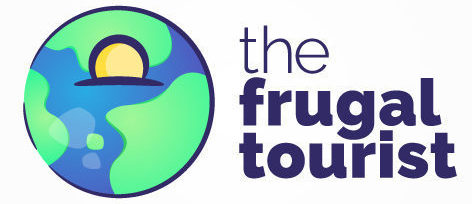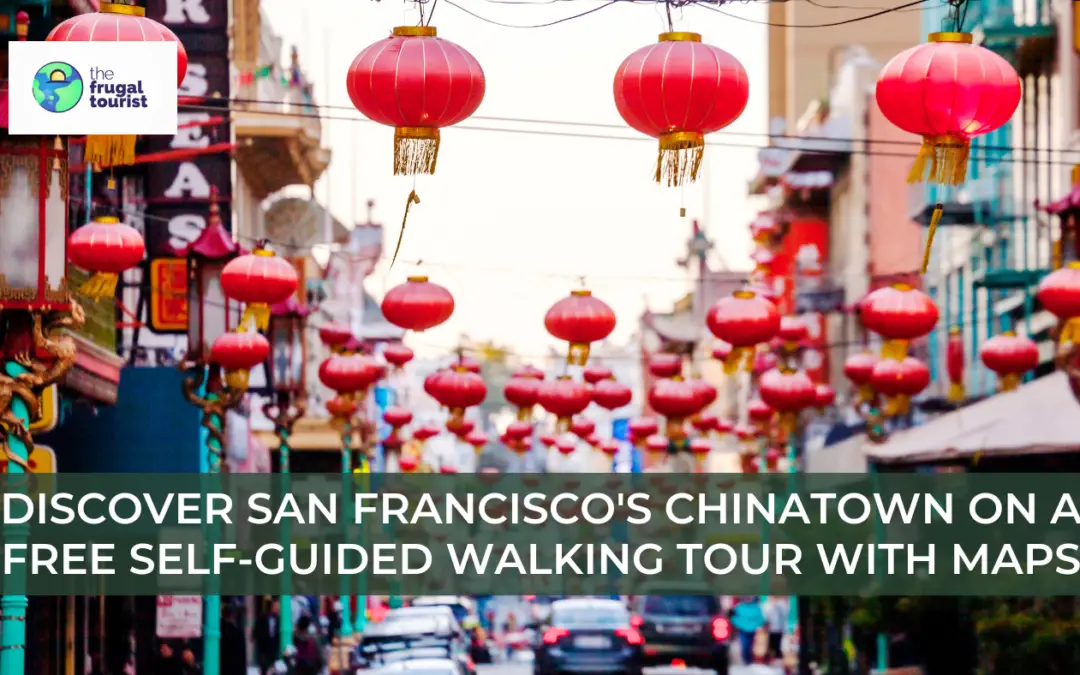ADVERTISER DISCLOSURE: The Frugal Tourist is part of an affiliate sales network and receives compensation for sending traffic to partner sites, such as MileValue.com and Cardratings. This compensation may impact how and where links appear on this site. This site does not include all financial companies or all available financial offers. Terms apply to American Express benefits and offers. Enrollment may be required for select American Express benefits and offers. Visit americanexpress.com to learn more. All information about the American Express Schwab Platinum has been collected independently by The Frugal Tourist.
EDITORIAL DISCLOSURE: Opinions, reviews, analyses & recommendations are the author’s alone and have not been reviewed, endorsed, or approved by any of these entities.
Chinatown is a must-see destination if you have an extra day in San Francisco.
Known as the oldest Chinatown in the world, this lively neighborhood offers an intriguing mix of historic landmarks, cultural institutions, and culinary delights.
Whether you’re a history buff, travel enthusiast, or local explorer, a free self-guided walking tour of Chinatown promises an unforgettable experience.
In this blog post, we’ll guide you through some of SF’s Chinatown’s most iconic stops, offering insights, tips, and a touch of history along the way.

The Enchanting History of San Francisco’s Chinatown
San Francisco’s Chinatown is more than just a bustling enclave; it’s a testament to the resilience and cultural richness of the Chinese-American community.
Established in the mid-19th century, it has weathered many storms, from the Gold Rush era to the 1906 earthquake.
Today, it’s a vibrant hub filled with cultural landmarks, shops, and eateries that attract both locals and tourists.
Walking through Chinatown is like taking a step back in time.
The architecture, featuring traditional Chinese motifs, looks stunning against San Francisco’s modern skyline.
From the intricate Dragon Gate to the serene temples, every corner tells a story.
Whether you’re visiting historical sites or enjoying culinary treats, there’s something for everyone.
The best part? Many attractions are free or low-cost, making it perfect for budget travelers.
Self-Guided Walking Tour Map
Feel free to download this self-guided walking tour map of San Francisco’s Chinatown on your mobile phone by clicking any of the maps below.
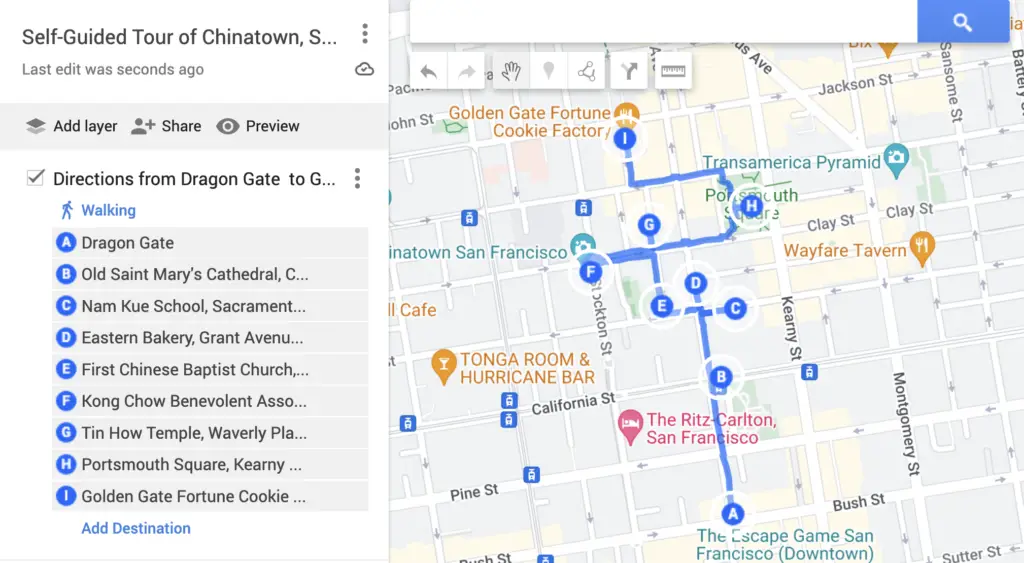
You can also easily share this downloadable walking tour map with anyone who is interested in exploring Chinatown soon.
San Francisco Chinatown Self-Guided Walking Tour Statistics
| Distance |
|---|
| Total: 1 mile |
| Without Stops: 22 minutes |
| With Stops: 2-3 hours |
San Francisco Chinatown Self-Guided Walking Tour Itinerary
A. Begin Your Journey at the Iconic Dragon Gate
Your self-guided tour of Chinatown begins at the Dragon Gate, the grand entrance marking the southern gateway to this fascinating neighborhood.
Located at the intersection of Bush Street and Grant Avenue, the gate is an iconic symbol of Chinatown’s cultural identity and significance.
The Dragon Gate is more than just an entrance; it’s a work of art.
It is adorned with traditional Chinese motifs, including dragons and koi fish, and represents strength, good fortune, and harmony.
Visitors often pause here to admire its beauty and take photos.
The gate’s history is as rich as its design. Built in 1970, it was a collaborative effort between the Chinese-American community and the city of San Francisco.
Today, it stands not only as a welcoming portal but also as a reminder of the enduring contributions of Chinese immigrants to the city’s cultural fabric.

B. Exploring Old St. Mary’s Cathedral and Square
From the Dragon Gate, walk up two blocks and turn right on California Street. St. Mary’s Cathedral will be on the left.
Just a short walk from the Dragon Gate lies Old St. Mary’s Cathedral and Square.
Built in 1854, it is the first Catholic cathedral in San Francisco. This landmark offers a glimpse into the area’s religious and cultural heritage.
The cathedral’s architecture mixes Gothic and Romanesque styles, with its towering spires creating a majestic outline against the city.
Inside, visitors can admire the beautiful stained glass windows and intricate woodwork, each piece telling a story of devotion and skill.
Across the cathedral, on California Street, is St. Mary’s Square, a peaceful place ideal for a relaxed walk or some quiet reflection.
You’ll come across a statue of Sun Yat-sen, an important figure in both Chinese and Chinese-American history, along with memorials for fallen Chinese-American soldiers and Comfort Women.
This is where history meets tranquility, giving you a deeper insight into the community’s past.

Must-See: Sin Chong Building
Across from Old St. Mary’s Church on Grant Street is Sin Chong Building. The best vantage point is from St. Mary’s Square.
Even though this iconic Chinatown landmark is permanently closed, it’s still worth checking out its magnificent facade.
Located at 601 Grant Avenue, right across from St. Mary’s Cathedral, the Sing Chong Building stands out with its unique pagoda-style design, making it one of Chinatown’s most photographed spots.
Sin Chong is said to be a symbol of the Chinese-American community’s resilience and cultural pride.
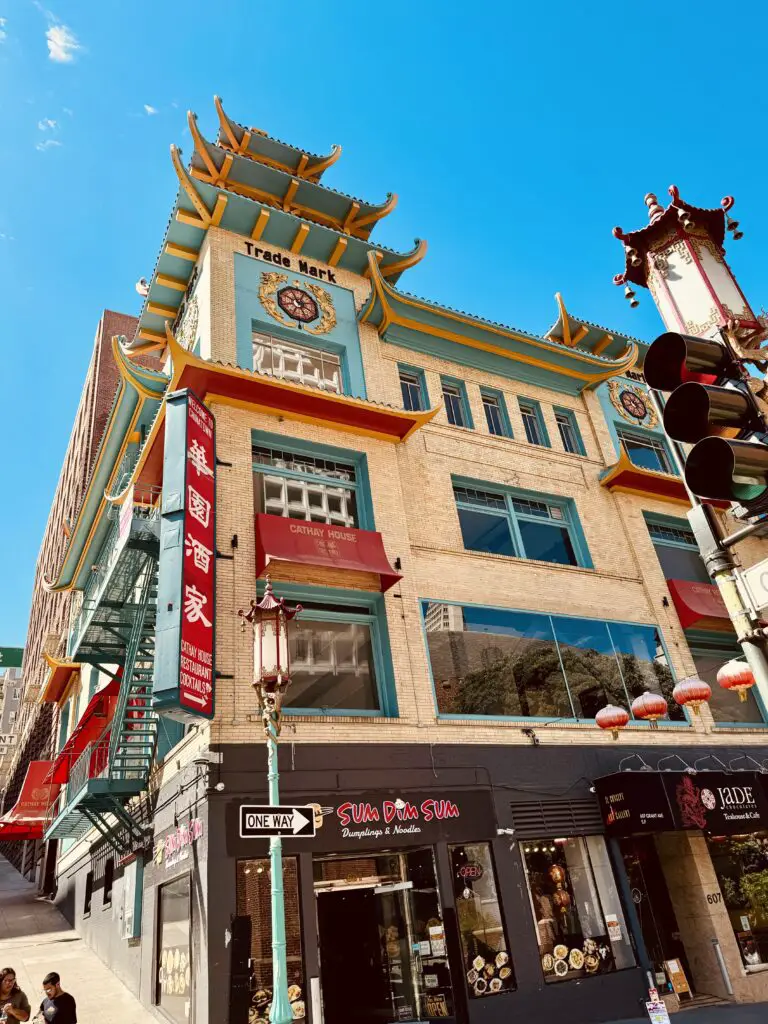
C. Nam Kue Chinese School and the Legacy of Education
Return to Grant Avenue and turn right on Grant. Walk one block up until you reach Sacramento Street. Turn right on Sacramento.
Continuing your tour, you’ll arrive at Nam Kue Chinese School at 755 Sacramento Street.
This institution plays a vital role in preserving and promoting Chinese culture and education among the younger generations in Chinatown.
The school helps kids learn Chinese writing and culture, boosting their identity and pride in their roots.
Visitors can check out the programs and see how they impact the community.
It’s a place where tradition blends with modern life, ensuring cultural knowledge is passed down through generations.
D. Eastern Bakery and the Flavors of Chinatown
Return to Grant Avenue and turn right. Eastern Bakery will be on your right.
No trip to Chinatown would be complete without indulging in its culinary delights, and Eastern Bakery is the perfect place to begin your gastronomic adventure.
Established in 1924, it’s the oldest Chinese bakery in Chinatown and is renowned for its delicious treats.
Located at 720 Grant Avenue, this bakery is famous for its mooncakes, a traditional Chinese delicacy enjoyed during the Mid-Autumn Festival.
In addition to mooncakes, Eastern Bakery offers various pastries and baked goods. From egg tarts to sesame balls, there’s something to satisfy every palate.
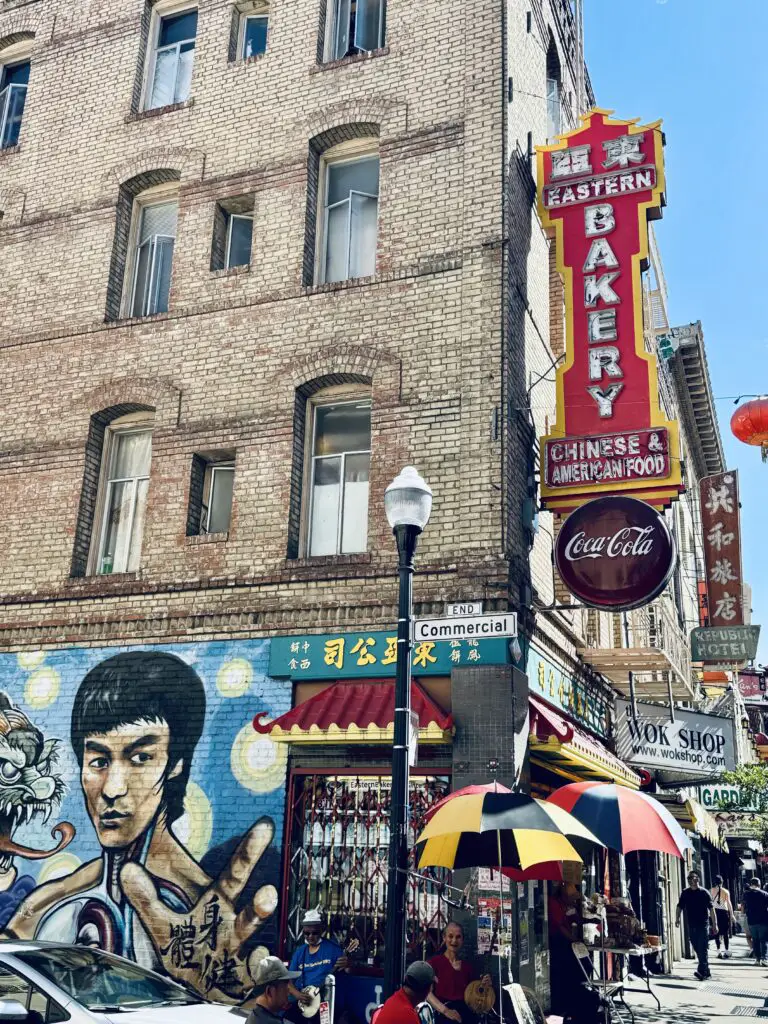
E. First Chinese Baptist Church
Head back to where you just came from – the intersection of Grant and Sacramento. Turn right on Sacramento and another right on Waverly Place.
On the next block, at 15 Waverly Place, the First Chinese Baptist Church stands as a testament to Chinatown’s spiritual and communal life.
Established in the early 20th century, it has played a vital role in supporting the community through worship, outreach, and social services.
Visitors can explore the church’s history and contributions to the neighborhood’s cultural fabric.
| Chinese Consolidated Benevolent Association of America |
|---|
| Waverly Place is home to several buildings for the Chinese Consolidated Benevolent Association of America (CCBA). Various associations created the CCBA in Chinatown to provide mutual aid and protection. This group, comprised of Chinese merchants and businessmen, arose to tackle Chinese immigrants’ socio-economic and political needs. Recognized as an organization in 1882, the CCBA was officially incorporated in 1901. |
F. Spiritual Center of Chinatown: Kong Chow Temple
Walk down Waverly Place until you reach the intersection with Clay Street. Make a left on Clay. Our next stop is at the corner of Clay and Stockton.
Chinatown has several spiritual centers, each offering a glimpse into the rich tapestry of religious and cultural practices. One of them is the Kong Chow Temple.
The Kong Chow Temple, dedicated to the Chinese deity Guan Yu, is a place where visitors can experience the spiritual side of Chinatown.
Located above the United States Postal Office branch in Chinatown, the temple’s detailed interior and vivid colors highlight its cultural significance, inviting visitors to explore its history and religious practices.
G. Another Spiritual Center: Tin How Temple
Circle back down where you came from at the intersection of Clay and Waverly Place. Turn left at Waverly Place.
Our next stop, 125 Waverly Place, is another spiritual center in the heart of Chinatown.
The Tin How Temple is one of the oldest, still-operating Chinese Taoist temples in the United States.
It is dedicated to the Chinese sea goddess Mazu, protector of sailors and fishermen, who is known in Cantonese as Tin How.
Visitors can explore the temple’s ornate interior, filled with offerings, incense, and ancient artifacts.
It’s a place of serenity and reflection, offering a deeper understanding of San Francisco’s Chinatown’s deep spiritual heritage.
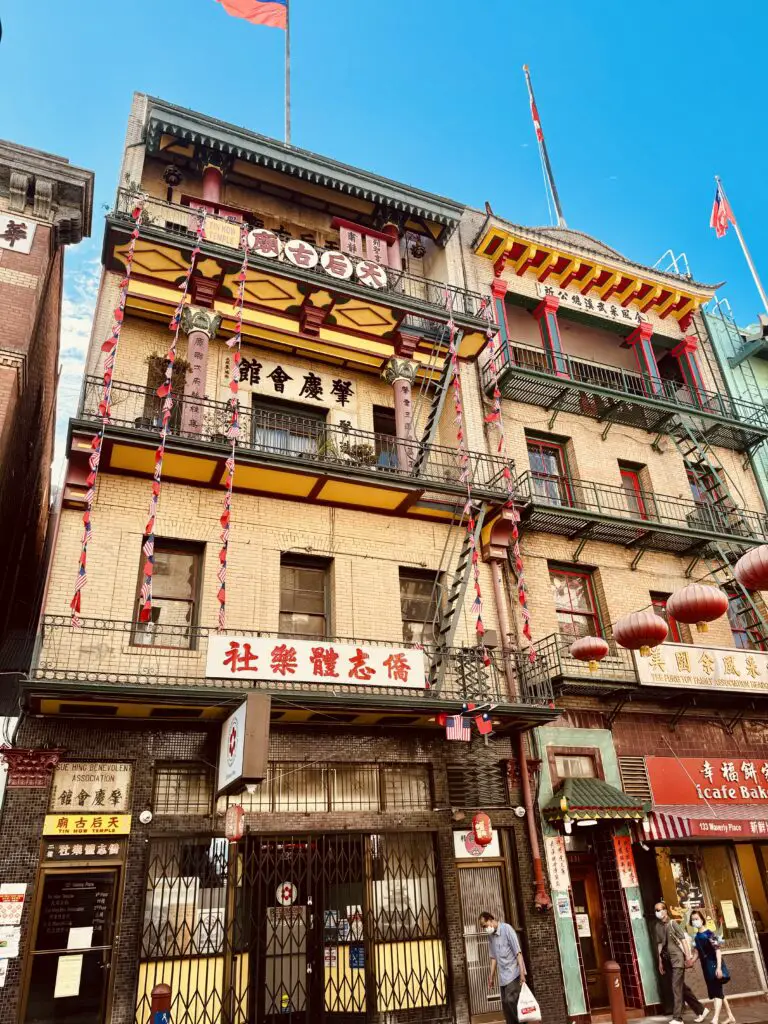
H. Portsmouth Square and Its Historical Legacy
Return to the corner of Waverly Place and Clay Street. Turn left on Clay then walk until you reach Portsmouth Square, on your left.
Portsmouth Square, often called the “Heart of Chinatown,” is a historic site that has played a central role in San Francisco’s history.
It’s a spot where the past meets the present, giving you a vibrant mix of cultural and historical significance.
The square has been the site of many critical events in San Francisco’s history, from the raising of the American flag in 1846 to the signing of the United Nations Charter in 1945.
Today, it’s a popular community gathering place, hosting events, festivals, and daily activities.
Visitors to Portsmouth Square can also explore its historical markers, statues, and plaques, each telling a story of the city’s past.
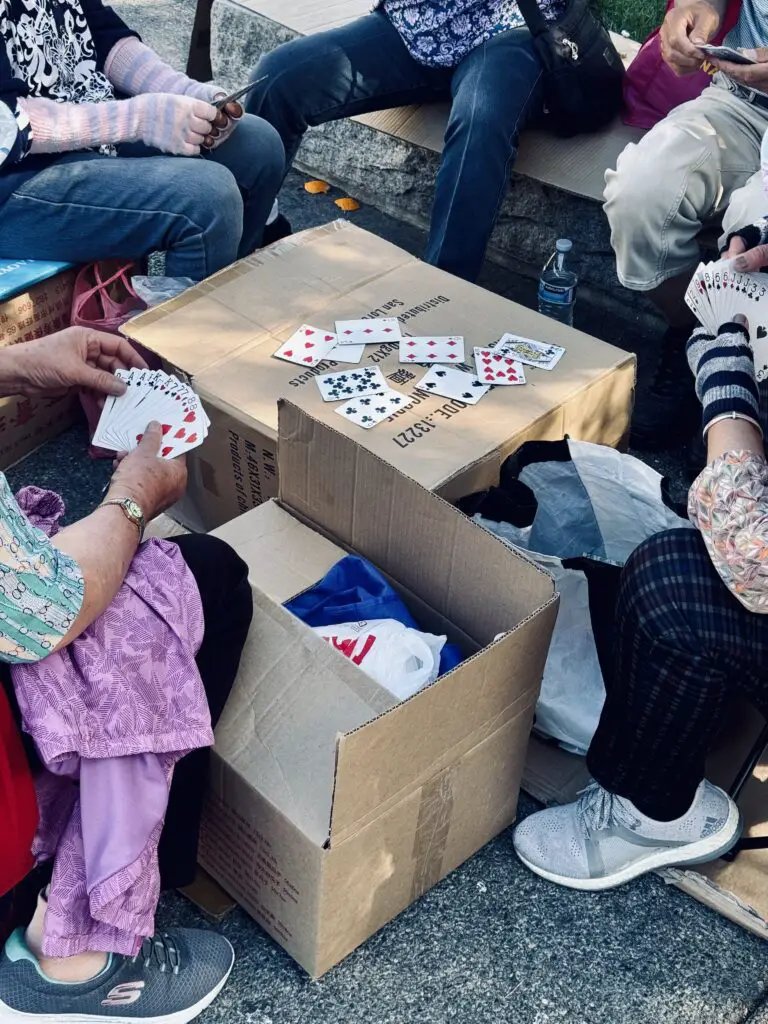
I. A Sweet Ending at the Golden Gate Fortune Cookie Factory
Walk towards the other end of Portsmouth Square on Washington Street. Turn left on Washington Street, then walk until you reach Ross Alley. Turn right on Ross until you arrive at 56 Ross.
Your self-guided tour ends with a visit to the Golden Gate Fortune Cookie Factory, where you can witness the art of fortune cookie making firsthand.
Located in a small alleyway, this factory is a hidden gem that offers a sweet end to your Chinatown adventure.
Visitors can watch as skilled artisans craft fortune cookies, each containing a unique message.
The factory offers samples, allowing visitors to savor the taste of freshly made fortune cookies.
The Golden Gate Fortune Cookie Factory is more than just a sweet treat; it’s a cultural experience that captures the spirit of Chinatown.
It’s a place where history, craftsmanship, and culinary delight come together, leaving visitors with a memorable taste of this vibrant neighborhood.
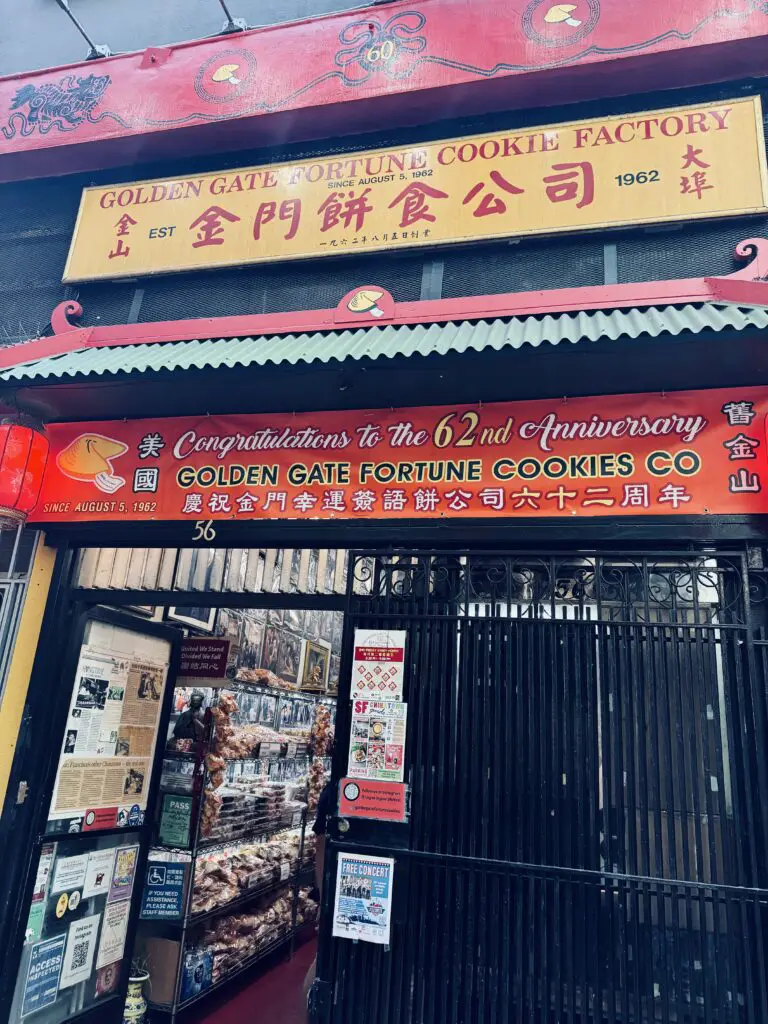
Tips for a Frugal and Enjoyable Self-Guided Tour
Exploring Chinatown doesn’t have to break the bank. Here are some tips to make your self-guided tour both frugal and enjoyable:
- Take advantage of free attractions. Many of Chinatown’s landmarks, such as the Dragon Gate and Portsmouth Square, are free to explore.
- Use hotel loyalty points for accommodations. Consider staying at nearby hotels like the Grand Hyatt San Francisco or Hilton Hotels, where you can redeem points for a more affordable stay. If you are new to traveling using miles and points, feel free to join our Free Travel Miles and Points Facebook Group.
- Enjoy budget-friendly dining options. From dumplings to dim sum, Chinatown offers a variety of affordable culinary experiences.
- Plan your visit during festivals. Chinatown hosts several cultural festivals throughout the year, offering free entertainment and activities for visitors.
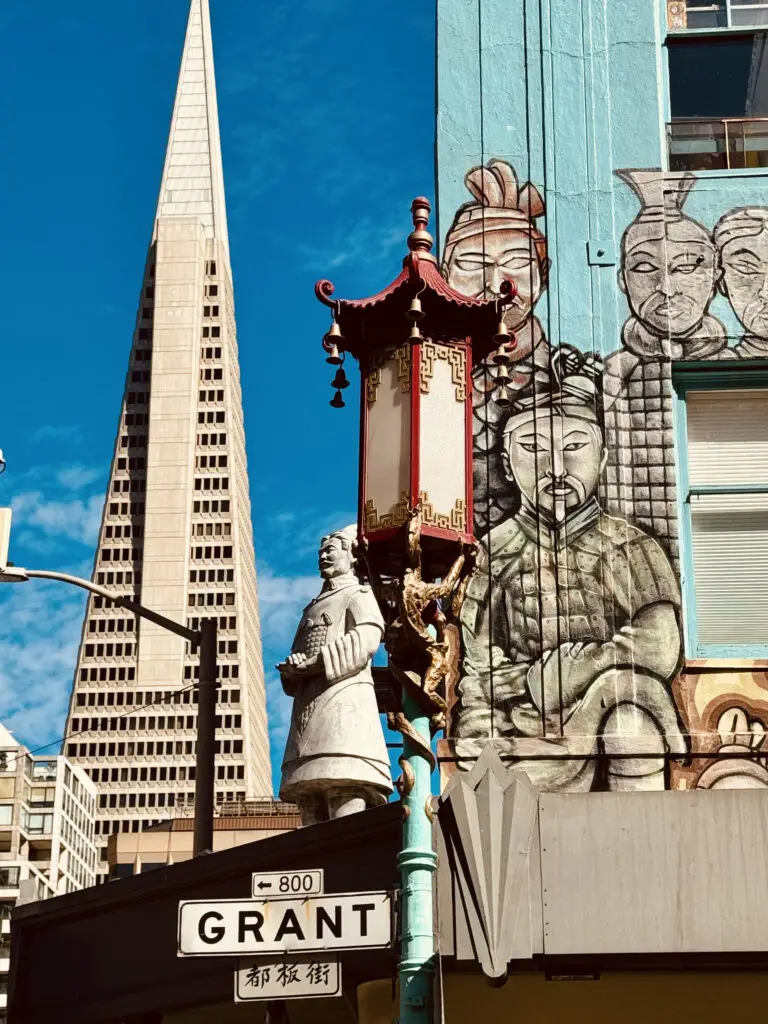
Frequently Asked Questions (FAQs)
When is the best season to visit Chinatown?
Each season in Chinatown offers something unique. Spring and autumn are particularly delightful with mild temperatures and vibrant festivals, making them the most popular times for visitors.
When is the best time of day to explore?
Morning and early afternoon are great for avoiding the crowds and experiencing the neighborhood at a leisurely pace.
You’ll have more time to enjoy the local shops and savor some delicious dim sum before the main tourist rush.
Is it safe to drive in Chinatown?
Driving in Chinatown can be challenging due to crowded streets and limited parking.
It’s generally better to park your car elsewhere and explore on foot, which lets you soak in all the sights and sounds.
And don’t forget to hide your valuables in your car if you’re driving to San Francisco!
Should we take public transport?
Absolutely! San Francisco’s efficient public transportation system—buses, trams, and BART—makes it easy to reach Chinatown.
Using public transport is a stress-free way to navigate the city and minimize your carbon footprint.
How long should we devote to our visit?
It depends on your interests, but a half-day is ideal for thoroughly exploring Chinatown’s intricate alleyways, unique shops, cultural landmarks, and dining options.
Take your time to enjoy this culturally rich area.
If you have an extra few days in San Francisco and would like to embark on other self-guided walking tours, feel free to check out our other recommended self-guided walks in San Francisco here.
What types of food should we try in Chinatown?
You should definitely start with some classic dim sum and then maybe move on to more adventurous dishes like Peking duck or hot pots.
Don’t forget to try some delicious bubble tea or a sweet egg tart for dessert!
Are there any paid guided tours available?
Yes, there are several guided tours available that take you through Chinatown’s historic streets, hidden gems, and culinary hotspots.
These tours are a great way to learn about the area’s history from an expert or make your visit more enjoyable and hassle-free.
Can we find souvenirs in Chinatown?
Absolutely!
Chinatown is brimming with shops full of unique gifts and souvenirs, from traditional Chinese crafts, tea sets, and herbal medicines to more modern trinkets like T-shirts and novelty items.
There’s something for everyone to remember about their visit!
Is Chinatown family-friendly?
Chinatown is incredibly family-friendly, with plenty to see and do for all ages.
Kids love the colorful architecture and bustling markets, not to mention the chance to watch a dragon dance or enjoy a family meal at a local restaurant.
Do we need cash, or are cards accepted?
While many places accept credit cards, it’s a good idea to bring some cash for smaller markets, street vendors, or traditional shops that may not have credit card capabilities.
Having both options will make your shopping experience smoother.
Are there any must-see festivals in Chinatown?
Honestly, anytime is a good time to visit Chinatown, but if you want to experience the area at its liveliest, consider visiting during a cultural festival like the Chinese New Year.
The energy is infectious, with vibrant parades, decorations, and traditional performances that are not to be missed.
Is Chinatown accessible for people with disabilities?
Chinatown has made strides in accessibility, with many restaurants and shops offering wheelchair access.
However, some of the older buildings and narrow sidewalks might pose challenges, so it’s always a good idea to check in advance with specific venues if you have concerns.
Are there vegetarian or vegan options available in Chinatown?
Absolutely, there are plenty of spots in Chinatown that cater to vegetarian and vegan diets.
Many restaurants offer vegetable-based dishes, tofu specialties, and plant-based dim sum options.
Just ask your server for recommendations, and they’ll be happy to help!
What should we wear when visiting Chinatown?
The dress code in Chinatown is pretty casual, so feel free to wear whatever makes you comfortable.
If you’re visiting in the summer, lightweight and breathable fabrics are ideal since it can get quite warm.
If you’re exploring during cooler months, a light jacket usually suffices.
Also, bring comfortable shoes because you’ll likely do a lot of walking to explore all the sights and sounds!
Are there any precautions to take while visiting Chinatown?
Chinatown is generally safe, but like any bustling neighborhood, it’s good to stay alert.
Keep an eye on your belongings, especially in crowded spots.
If you’re visiting during a festival, be prepared for large crowds and plan meeting spots with friends or family if you get separated.
Is there Wi-Fi available in Chinatown?
While some cafes and restaurants offer Wi-Fi, it’s not as widespread as in other parts of the city.
If you plan on using your devices frequently during your visit, it’s a good idea to have a data plan on your phone.
Can we bring pets to Chinatown?
Pets are welcome in Chinatown, but not all eateries and shops allow pets inside.
Always keep your furry friends on a leash and try to stick to outdoor areas.
It’s also courteous to clean up after them to keep the area pleasant for everyone.
Walking Tour Essentials
Exploring Chinatown on foot is an amazing way to soak in the vibrant culture and bustling atmosphere, but you’ll want to be prepared to ensure a comfortable visit.
- A pair of comfortable walking shoes is a must since you’ll cover a lot of ground.
- Depending on the time of year, a light jacket can be handy in case it gets a bit chilly.
- If it’s sunny, remember sunscreen to protect your skin and a sunhat and sunglasses to shield you from the rays.
- Staying hydrated is key, so bring along a bottle of water.
- Carry your essentials in a small backpack, perfect for hands-free exploring.
- A camera is essential for capturing those colorful moments you’ll encounter at every turn.
- Cash is still king in some places, so it’s smart to carry a bit along with your credit cards for convenience.
Other San Francisco Posts/Tours
Please click the image below to be redirected to all the other blog posts and FREE walking tours in San Francisco.
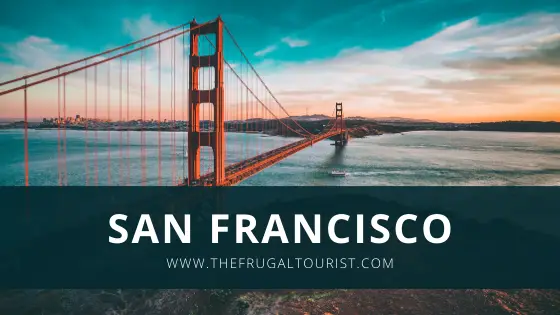
Before your Trip to San Francisco
Where to Stay
San Francisco is expensive, even for locals.
For tourists, I suggest using credit card points and free night awards to save some cash.
I got this free stay at the Kimpton Alton in San Francisco’s Fisherman’s Wharf area from my IHG One Rewards Premier Business Credit Card.
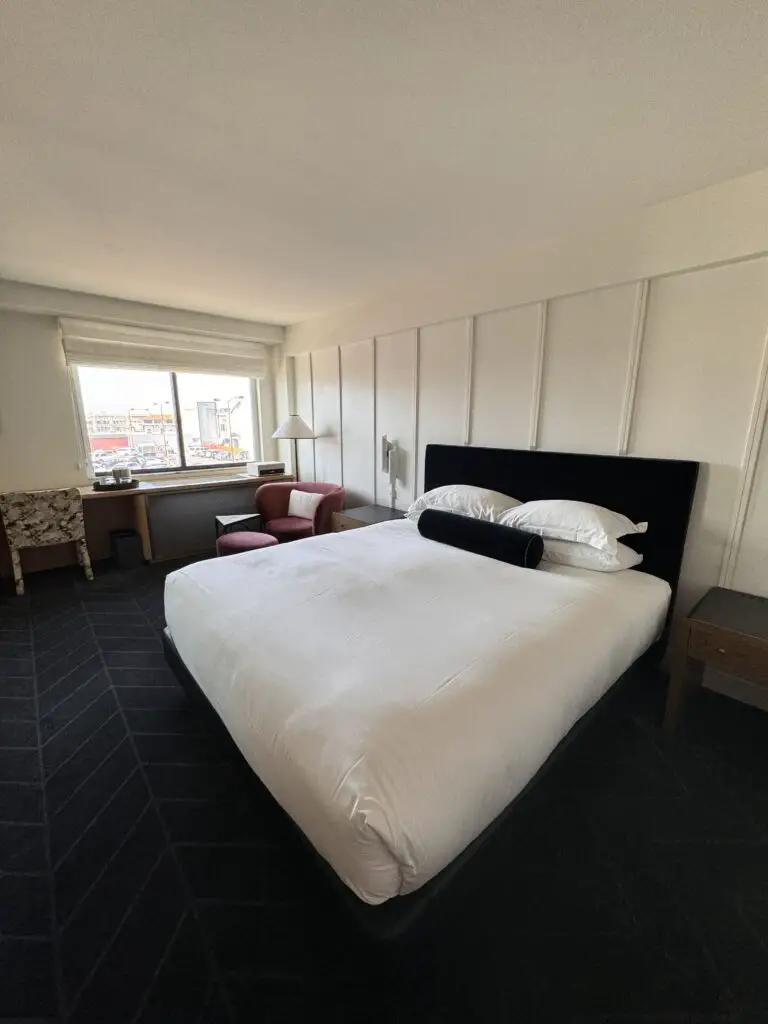
I also recommend the Hyatt Centric Fisherman’s Wharf Hotel, located a minute away from the Kimpton.
I stayed here for free using the World of Hyatt points I earned from my Chase Sapphire Preferred® Card and World of Hyatt Business Credit Card.
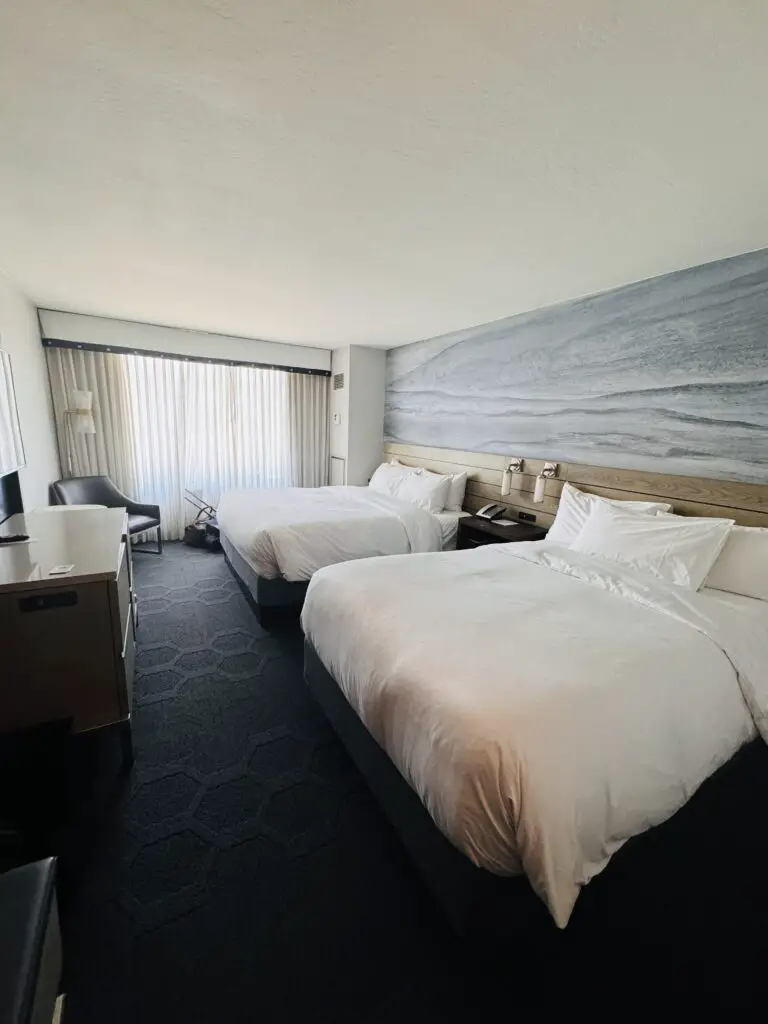
Travel Insurance
How to FLY to San Francisco for almost FREE
All of my trips over the past decade have been ALMOST FREE via travel miles and points.
I accumulate these points from credit card rewards and bonuses.
Some of these credit cards are featured here.
If you are new to traveling using miles and points, join us in our Free Travel Miles and Points Facebook Group.

Final Thoughts
San Francisco’s Chinatown is where history, culture, and community blend together, giving visitors an unforgettable experience.
From historic spots to delicious food, there’s something for everyone.
Your self-guided walking tour is just a taste of what this lively neighborhood has to offer.
Whether you’re a local or a traveler, Chinatown invites you to explore, learn, and savor the richness of its cultural heritage.
We hope you’ve enjoyed this exploration of Chinatown and feel inspired to continue your journey of discovery.
ADVERTISER DISCLOSURE: The Frugal Tourist is part of an affiliate sales network and receives compensation for sending traffic to partner sites, such as MileValue.com and Cardratings. This compensation may impact how and where links appear on this site. This site does not include all financial companies or all available financial offers. Terms apply to American Express benefits and offers. Enrollment may be required for select American Express benefits and offers. Visit americanexpress.com to learn more. All information about the American Express Schwab Platinum has been collected independently by The Frugal Tourist.
EDITORIAL DISCLOSURE: Opinions, reviews, analyses & recommendations are the author’s alone and have not been reviewed, endorsed, or approved by any of these entities.
USER-GENERATED CONTENT DISCLOSURE: The comments section below is not provided or commissioned by the bank advertiser. Responses have not been reviewed, approved, or otherwise endorsed by the bank advertiser. It is not the bank advertiser’s responsibility to ensure all questions are answered.
